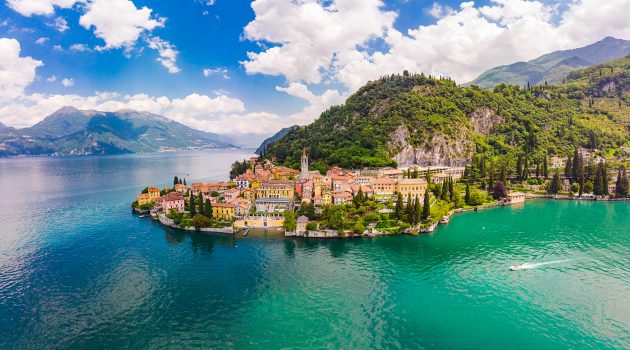Of glacial origin, it has constituted enormous importance since ancient times as a way of communication between the countries in the north and those of the Po Valley, and also with the countries beyond the Alps thanks to the nearby passes of Spluga and Maloja.
The surface of the lake is 146 sq km, with a perimeter development of 170 km. and an altitude above sea level of 198 meters. In the north it receives the waters of the Adda river, which exits in Lecco and after a long course flows into the Po. The Lario divides in the South into the branches of Como and Lecco, which flow into the tip of Bellagio, then narrows gradually towards North, in the only branch of Colico, assuming the characteristic shape of an inverted ipsilon which makes it readily identifiable on each geographical map. From Como to Gera Lario, where it ends, its length is 50 km.
In the Como branch, in front of Sala Comacina, there is the only island on the lake, Isola Comacina, with important Roman finds, an oasis of peace for artists and nature lovers, connected to the mainland by a boat service.
Climatic locations of excellence, its shores are dotted with small towns where imposing villas of refined architecture of the eighteenth and nineteenth centuries arise, surrounded by magnificent parks, some of which, open to visitors, have been a favorite destination for tourists of all time since the past, especially foreigners: in Bellagio Villa Serbelloni and Villa Melzi, in the hamlet Loppia Villa Trivulzio; in Varenna Villa Monastero; in Tremezzo Villa Carlotta; in Lenno Villa Balbianello; in Menaggio Villa Mylius Vigoni.
The waters of Lake Como are extremely changeable, from calm and motionless they can suddenly agitate becoming dark and dangerous due to the winds blowing in the different areas and are responsible for the good or bad weather that is. Tivano, Breva, Menaggino, Bellanasco, winds from the central northern area of Lario, as well as giving the name to exercises, publications, gatherings, if identified by the direction and time in which they expire, make many inhabitants of the area reliable weather forecasts short term.

